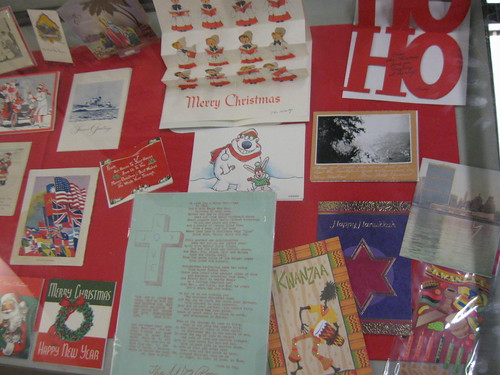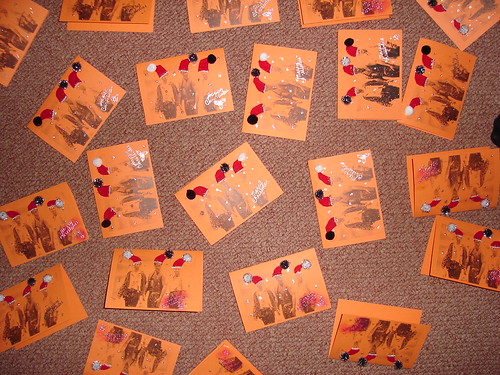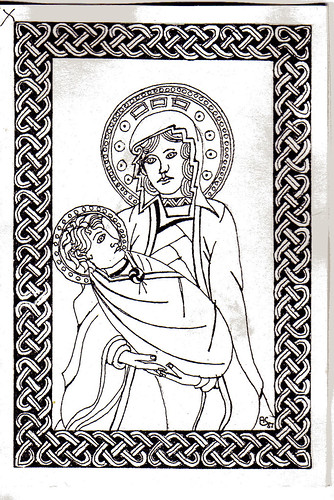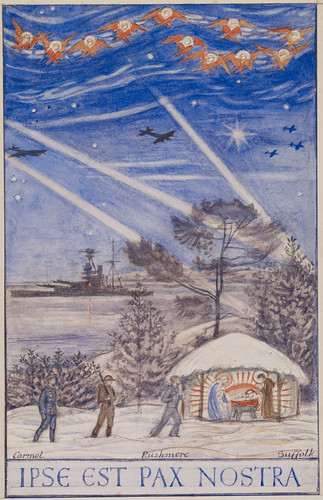Middle Part of "Seasons Greetings: Holiday Cards" Exhibit Case
Image by Special Collections Research Center, Swem Library
Shown here is a picture of the middle section of the "Seasons Greetings: Holiday Cards" exhibit case on display inside the front door on the 1st floor of Swem Library at the College of William and Mary. The exhibit features Christmas, Hanukkah, and Kwanzaa cards from the late 19th century through the 1960s.
The following is from the labet text for the exhibit:
Christmas cards are modern inventions rooted in old traditions. Ancient Romans and medieval Europeans sent New Year’s greetings. By the early 1800s in both England and America, people used illustrated notepaper to send Christmas letters to distant loved ones and gave out New Year’s calling cards. The first Christmas card dates to 1843, when Englishman Henry Cole commissioned painter John Calcott Horsley to design one. By the 1860s, the development of color printing made Christmas cards readily available in England, and Americans eagerly imported them. A Boston-based lithographer, Louis Prang, in 1875 began printing and selling his own card. By 1882, he was printing five million Christmas cards annually. The growing popularity of Christmas cards resulted from the spread of free mail delivery and the invention of a traditional American Christmas in the late 1800s. Buffeted by industrialization and urbanization, threatened culturally by mass immigration from Europe, and distanced from loved ones by Americans' geographic mobility, wealthy and middle-class Americans created a modern Christmas full of acts and rituals that harkened back to an imaginary simpler time.
Nineteenth-century Christmas cards rarely featured religious scenes. The early cards depicted flowers, trees, and birds. By the late 1800s, images grew more seasonal with greens such as ivy or holly; winter scenes such as a snow-covered church or ice skaters; or children sledding, playing with dolls, or engaged in similar activities.
By 1900, many Americans despaired over just how commercial Christmas had become and how materialistic the emphasis on gift-giving made the holiday. People turned to cards as a substitute for presents. Most popular were Christmas postcards, usually imported from Germany, depicting typical modern Christmas images such as Santas or Christmas trees. They sometimes also pointed to new technology such as cars or telephones. The first decade of the 1900s saw the establishment of major American greeting card firms, including Hallmark, Gibson, and Rust Craft. They often produced folded greeting cards with a picture and some text on the outside, lengthier text inside, and a blank page for the sender to personalize.
World War I was a milestone for Christmas cards. Anti-German feeling in the country led many Americans to boycott German goods even before the U.S. entered the War and helped end the dominance of German cardmakers in the U.S. market. Religious scenes remained uncommon. Many cards simply wished the recipient "Season's Greetings" rather than mentioning Christmas. One observer complained that the cards "might have been designed by the President of the Moscow Society of the Godless, so far as any suggestion of the Nativity was concerned." During the 1920s, "Olde English" motifs associated the senders with the upper class and with a traditional Christmas. Also popular, however, were modern cards with sleek Art Deco graphics. During the Depression of the 1930s, cards typically were small and relatively simple in color and design.
World War II brought patriotic cards and special cards from military units. During the postwar period into the 1960s, cards depicted traditional images such as Santa Claus and snowmen. Personalization continued to be popular, with photographs adding another personal touch. The 1960s witnessed an explosion of cards sold to benefit good causes, such as UNICEF and other charities and museums.
The late 1900s also saw two other types of year-end cards. Hanukkah became more prominent as a Jewish holiday, and Hanukkah cards soon followed. In 1966, Maulanga Ron Karenga created Kwanzaa, a seven-day African American celebration highlighting principles such as unity and self-determination and sometimes people send Kwanzaa cards.
Christmas cards, meanwhile, have moved in both new directions and old. Religious cards now constitute more than 25% of sales. Humorous cards also claim a share of the market. At the same time, many people now send printed letters full of news—the letter on display here is extraordinarily early—bringing us back full circle to the Christmas letters of the early 1800s.
All material is from the Special Collections Research Center, Earl Gregg Swem Library. Curator: Beatriz Hardy, Director; Exhibit Design and Installation: Chandi Singer, Warren E. Burger Archives Specialist.
Right-Hand Side of "Seasons Greetings: Holiday Cards" Exhibit Case
Image by Special Collections Research Center, Swem Library
Shown here is a picture of the right-hand side of the "Seasons Greetings: Holiday Cards" exhibit case on display inside the front door on the 1st floor of Swem Library at the College of William and Mary. The exhibit features Christmas, Hanukkah, and Kwanzaa cards from the late 19th century through the 1960s.
The following is from the labet text for the exhibit:
Christmas cards are modern inventions rooted in old traditions. Ancient Romans and medieval Europeans sent New Year’s greetings. By the early 1800s in both England and America, people used illustrated notepaper to send Christmas letters to distant loved ones and gave out New Year’s calling cards. The first Christmas card dates to 1843, when Englishman Henry Cole commissioned painter John Calcott Horsley to design one. By the 1860s, the development of color printing made Christmas cards readily available in England, and Americans eagerly imported them. A Boston-based lithographer, Louis Prang, in 1875 began printing and selling his own card. By 1882, he was printing five million Christmas cards annually. The growing popularity of Christmas cards resulted from the spread of free mail delivery and the invention of a traditional American Christmas in the late 1800s. Buffeted by industrialization and urbanization, threatened culturally by mass immigration from Europe, and distanced from loved ones by Americans' geographic mobility, wealthy and middle-class Americans created a modern Christmas full of acts and rituals that harkened back to an imaginary simpler time.
Nineteenth-century Christmas cards rarely featured religious scenes. The early cards depicted flowers, trees, and birds. By the late 1800s, images grew more seasonal with greens such as ivy or holly; winter scenes such as a snow-covered church or ice skaters; or children sledding, playing with dolls, or engaged in similar activities.
By 1900, many Americans despaired over just how commercial Christmas had become and how materialistic the emphasis on gift-giving made the holiday. People turned to cards as a substitute for presents. Most popular were Christmas postcards, usually imported from Germany, depicting typical modern Christmas images such as Santas or Christmas trees. They sometimes also pointed to new technology such as cars or telephones. The first decade of the 1900s saw the establishment of major American greeting card firms, including Hallmark, Gibson, and Rust Craft. They often produced folded greeting cards with a picture and some text on the outside, lengthier text inside, and a blank page for the sender to personalize.
World War I was a milestone for Christmas cards. Anti-German feeling in the country led many Americans to boycott German goods even before the U.S. entered the War and helped end the dominance of German cardmakers in the U.S. market. Religious scenes remained uncommon. Many cards simply wished the recipient "Season's Greetings" rather than mentioning Christmas. One observer complained that the cards "might have been designed by the President of the Moscow Society of the Godless, so far as any suggestion of the Nativity was concerned." During the 1920s, "Olde English" motifs associated the senders with the upper class and with a traditional Christmas. Also popular, however, were modern cards with sleek Art Deco graphics. During the Depression of the 1930s, cards typically were small and relatively simple in color and design.
World War II brought patriotic cards and special cards from military units. During the postwar period into the 1960s, cards depicted traditional images such as Santa Claus and snowmen. Personalization continued to be popular, with photographs adding another personal touch. The 1960s witnessed an explosion of cards sold to benefit good causes, such as UNICEF and other charities and museums.
The late 1900s also saw two other types of year-end cards. Hanukkah became more prominent as a Jewish holiday, and Hanukkah cards soon followed. In 1966, Maulanga Ron Karenga created Kwanzaa, a seven-day African American celebration highlighting principles such as unity and self-determination and sometimes people send Kwanzaa cards.
Christmas cards, meanwhile, have moved in both new directions and old. Religious cards now constitute more than 25% of sales. Humorous cards also claim a share of the market. At the same time, many people now send printed letters full of news—the letter on display here is extraordinarily early—bringing us back full circle to the Christmas letters of the early 1800s.
All material is from the Special Collections Research Center, Earl Gregg Swem Library. Curator: Beatriz Hardy, Director; Exhibit Design and Installation: Chandi Singer, Warren E. Burger Archives Specialist.
Rammstein Xmas Card group
Image by clancy123
I knew that Art & Design degree would come in handy!
Card
Image by Kaptain Kobold
A Christmas card design I did back in 1987, when I had a bit of a thing for drawing Celtic knot patterns.
Design for a Christmas Card by Margaret Rope
Image by Birmingham Culture
Design for a Christmas Card, c.1939-45
by Margaret Rope, Sister Margaret of the Mother of God (1882-1953)
Margaret Rope was a stained-glass artist who studied at the Birmingham School of Art between 1901 and 1909 and later became a Carmelite nun. This design for a Christmas card was made for her convent during the Second World War. It shows a contemporary soldier, sailor and airman approaching the stable at Bethlehem, and angels watching over a sky filled with planes and searchlights. The Latin inscription ‘Ipse est pax nostra’ ('He is our peace') proclaims Jesus a source of comfort and hope, especially in time of war.
Copyright Birmingham Museums and Art Gallery
No comments:
Post a Comment